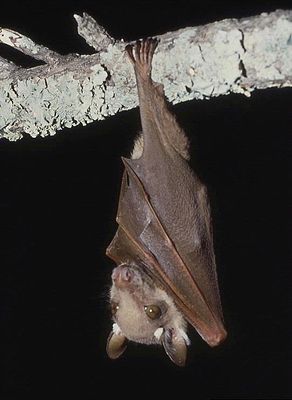Wahlberg epaulette bat
| Wahlberg epaulette bat | ||||||||||||
|---|---|---|---|---|---|---|---|---|---|---|---|---|

Wahlberg epaulette bat ( Epomophorus wahlbergi ) |
||||||||||||
| Systematics | ||||||||||||
|
||||||||||||
| Scientific name | ||||||||||||
| Epomophorus wahlbergi | ||||||||||||
| ( Sundevall , 1846) |
The Wahlberg epaulette bat ( Epomophorus wahlbergi ), also known as Wahlberg's epaulette bat , is a flying fox of the genus Epomophorus that is common in southern Africa .
description
The Wahlberg epaulette bat is a medium-sized flying fox with a weight of 54 to 125 g and a wingspan of 51 to 60 cm . The males have the tufts of hair typical of epaulette bats on the shoulders, where there are also sac-like glands. The fur is brown except for two whitish-yellow spots at the base of the ears. The Wahlberg epaulette bat looks very similar to its sister species Epomophorus crypturus , although their areas of distribution partially overlap. The two types can only be distinguished on the basis of the tooth morphology.
Way of life
Wahlberg epaulette batons can be found in savannah and woodland. They get by in dry regions with just 250 mm of precipitation per year and in wetter areas with an average rainfall of 700 mm. During the day, Wahlberg epaulette flying dogs hang in groups of up to 100 animals in trees with dense foliage. Other epaulette bats, such as Epomophorus labiatus or the Gambian epaulet bat, can sometimes be found in the same trees . At dusk, the females search for food up to 4 km from their sleeping place, while the males search for food a maximum of 500 m from their sleeping tree.
The diet of the Wahlberg epaulette bats mainly consists of figs , but also persimmons and guavas . The fruit is picked and carried to a feeding place, where the animals drink the juice, but drop the peel and the kernels. This makes the Wahlberg epaulette bat an important sperm disperser . In addition, this species eats the leaves of two Balanites species and drinks the nectar of various large flowers such as those of the baobab tree , where it takes on the function of a pollinator .
Reproduction
Wahlberg female epaulette bats are seasonally polyestrial and can give birth twice a year. The first young animal is usually born in February or March, while the second young animal is born between October and December. Each litter consists of one or two boys. The birth of the first litter takes place in the rainy season with the maximum supply of fruit, but the second birth falls in the dry season. It is believed that the females control the time of first birth so that it falls during the time with the highest food supply. With a gestation period of 5 to 6 months, however, it is not possible for them to give birth a second time during the rainy season. The young animals are suckled for 6 months and at 15 months they reach the weight of an adult. Females can become pregnant in the second mating season after their birth, while males are not sexually active until the third mating season.
distribution and habitat
The Wahlberg epaulette bat occurs from Uganda and Somalia to Angola and South Africa , and along the Atlantic coast to Gabon . Thanks to its widespread use, the IUCN classifies its population as safe.
literature
- L. Acharya (1992): Epomophorus wahlbergi , Mammalian Species 394: pp. 1-4
Web links
Individual evidence
- ↑ Epomophorus wahlbergi in the Red List of Threatened Species of the IUCN .

